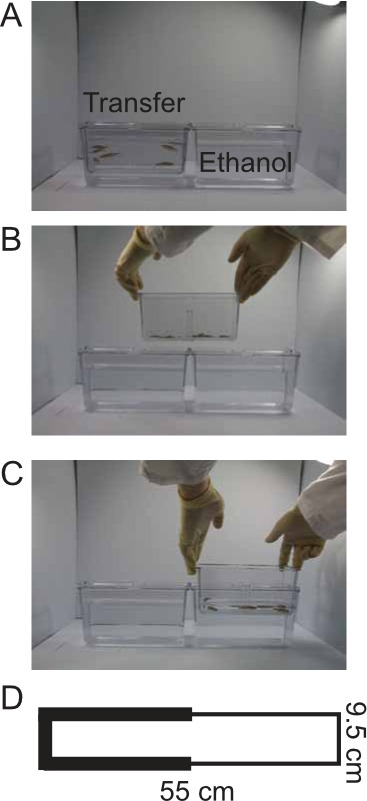Light-Dark Preference Test: A Method to Study Anxiety-Related Behavior in Zebrafish
Abstract
Source: Holcombe, A., et al. A Novel Method of Drug Administration to Multiple Zebrafish (Danio rerio) and the Quantification of Withdrawal. J. Vis. Exp. (2014)
The video describes the light-dark preference assay to study the anxiety-related behavior in zebrafish following the exposure to ethanol.
Protocol
1. Behavioral Testing
- Obtain a light/dark arena 9.5 cm wide by 55 cm long and 9.5 cm deep with a white waterproof floor (Figure 1B). Affix white and black waterproof non-reflective paper to the inside walls of the arena using velcro, with half of the arena covered in white and half covered in black. Fill the arena to a depth of 5 cm with habitat water at a temperature of 25-28 °C. Maintain this temperature throughout testing.
- Minimalize external visual stimuli by constructing a white three-sided enclosure for the arena to be situated in. Ensure the testing area has diffuse overhead lighting that does not cause reflections on the water surface, yet is sufficiently bright for the movement tracking software, or post-hoc manual quantification from video images.
- Place the arena in the enclosure and set the recording and movement analysis parameters of the behavior tracking software. Set the trial duration to 5-15 min, depending on the research question.
NOTE: Here, we used 5 min. - Transport the group of fish to be tested to the research area in the habitat tank and place them outside of the arena enclosure. Acclimate the fish for 10 min.
- Gently net a fish from the appropriate group and place in the center of the light/dark arena, being sure to release the fish when it is positioned parallel to the long axis of the arena to avoid biasing the fish to the light or dark zone.
- Begin recording behavior immediately after the animal is released. Watch for any software problems with tracking the fish or for fish jumping or freezing. Rotate the arena 180° after half of the subjects have been tested to prevent any confounds due to biases resulting from which end of the arena is oriented toward the open end of the enclosure.
- After the trial has ended, gently net and remove the fish from the arena to a holding tank or habitat tank.
2. Analysis
- Examine time spent in light versus dark zones. For each group and each fish, obtain the relative time spent in the light and dark zones and analyze using a one sample t-test (or Wilcoxon signed rank test for nonparametric data; difference from (half of the total trial time) 150 sec) to determine if groups significantly prefer one area over the other.
- To compare preferences, calculate a preference index by subtracting the time spent in the light zone from the time spent in the dark zone and compare differences between groups. t-tests can be used to compare two groups. Compare multiple groups with a one-way analysis of variance utilizing Tukey’s HSD post hoc test where necessary (or Kruskal-Wallis test with Dunn’s multiple comparison post hoc test for nonparametric data).
- Compare velocity, number of zone transitions, meandering, and immobility across groups. Use one-way analysis of variance utilizing Tukey’s HSD post hoc test where necessary (or Kruskal-Wallis test with Dunn’s multiple comparison post hoc test for nonparametric data).
Representative Results

Figure 1: Transfer Procedure and the Light/Dark arena. These photos illustrate the transfer procedure. (A) First, the fish are situated in the transfer tank (left). Dosing tank containing ethanol is pictured (right). (B-C) Moving the fish from the transfer tank to the ethanol solution requires the researcher to lift the spawning insert out of the transfer tank and into the ethanol solution tank. (D) The light/dark arena as illustrated measured 9.5 cm wide by 9.5 cm deep and 55 cm long. White flooring is used, along with black walls on half of the arena (left) and white walls on the other half, creating a light and dark zone.
Materials
| Light/Dark Arena | Custom | Construct as per procedure description. 9.5 cm wide, 9.5 cm deep, 55 cm long. | |
| Three shelf benchtop housing system | Aquatic Habitats | N/A | |
| 1.5 L Spawning tank w/400 μm baffle | Aquatic Habitats | N/A | |
| Ethovision XT Motion tracking software | Noldus Information Technology | ||
| Pure Grain Ethanol | Luxco, INC | N/A |

